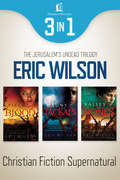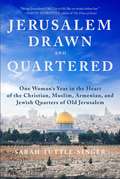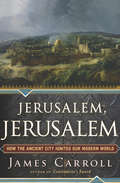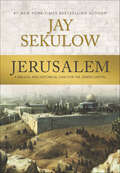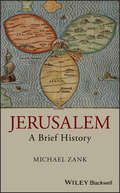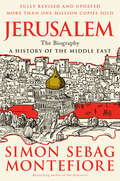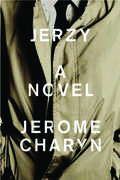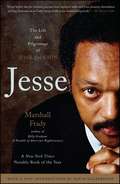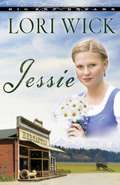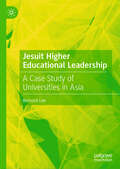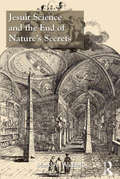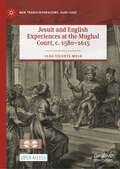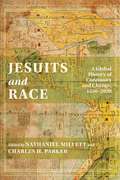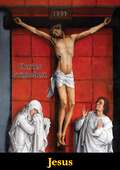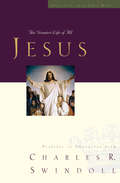- Table View
- List View
Jerusalem's Undead Supernatural 3-in-1 Bundle (Jerusalem's Undead Trilogy)
by Eric WilsonDiscover the Jerusalem's Undead trilogy in this 3-in-1 eBook bundle from author Eric Wilson.The suicide of Judas Iscariot in AD 30 left his blood seeping into the soil of the Field of Blood, in Aramaic the Akeldama. This tainted blood caused a counterfeit resurrection of the dead--the Collectors, who seek to corrupt and destroy. When Jesus was resurrected, ancient scripture says many rose from the grave. Today, 36 from this group of undead remain--the Nistarim, who are here to watch over the world and protect against the Collectors.Field of Blood follows Gina Lazarescu, a Romanian girl with a scarred past who has no idea she is being sought by these undead. Gina realizes her future will depend on her understanding of the past, yet how can she protect herself from Collectors who have already died once but still live?Gina's journey continues in Haunt of Jackals. The Nistarim and the Collectors are after a single target--a boy named Pavel who may possess the key to the Collectors' unlimited power . . . or ultimate downfall. Gina has survived one battle with the undead already and is determined to protect Pavel at all costs. But she has no idea how long she can stay a step ahead of the Collectors.In the final installment of the Jerusalem's Undead Trilogy--Valley of Bones--readers will witness an epic showdown of a battle between good and evil that started with the suicide of Judas Iscariot. Gina Lazarescu's life has been on a collision course with the Akeldama Collectors. She knows she can't defeat them on her own, though, and that it will take the combined efforts of all Those Who Resist for this living evil to be stopped.
Jerusalem, Drawn and Quartered: One Woman's Year in the Heart of the Christian, Muslim, Armenian, and Jewish Quarters of Old Jerusalem
by Sarah Tuttle-SingerOn a night in 1999 when Sarah Tuttle-Singer was barely 18, she was stoned by Palestinian kids just outside one of the gates to the Old City of Jerusalem. In the years that followed, she was terrified to explore the ancient city she so loved. But, sick of living in fear, she has now chosen to live within the Old City's walls, living in each of the four quarters: Christian, Muslim, Armenian, and Jewish. Jerusalem’s Old City is the hottest piece of spiritual real estate in the world. For millennia empires have clashed and crumbled over this place. Today, the conflict between Israelis and Palestinians plays out daily in her streets, and the ancient stones run with blood. But it’s also an ordinary city, where people buy vegetables, and sooth colicky babies, where pipes break, where the pious get high, and young couples sneak away to kiss in the shadows. Sarah has thrown herself into the maelstrom of living in each quarter—where time is measured in Sabbath sunsets and morning bells and calls to prayer, in stabbing attacks and check points—keeping the holidays in each quarter, buying bread from the same bread seller, making friends with people who were once her enemies, and learning some of the secrets and sharing the stories that make Jerusalem so special, and so exquisitely ordinary. Jerusalem, Drawn and Quartered is a book for anyone who’s wondered who really lives in Israel, and how they coexist. It’s a book that skillfully weaves the personal and political, the heartwarming and the heart-stopping. It’s a book that only Sarah Tuttle-Singer can write. The Old City of Jerusalem may be set in stone, but it’s always changing—and these pages capture that.
Jerusalem, Jerusalem: How the Ancient City Ignited Our Modern World
by James CarrollA &“masterful&” history of the city and its holy wars past and present, from the New York Times–bestselling author of Constantine&’s Sword (The Boston Globe). How did this ancient Middle Eastern city become a transcendent fantasy that ignites religious fervor unlike anywhere else on earth? Jerusalem, Jerusalem journeys through centuries of conflict among Jews, Christians, and Muslims, right up to the present-day Israeli-Palestinian struggle—with fascinating examinations of how the idea of the holy city has shaped not just the region&’s history but the world&’s.
Jerusalem: A Biblical and Historical Case for the Jewish Capital
by Jay SekulowIn his new book, New York Times bestselling author Jay Sekulow presents a political and historical rationale for the existence of Israel as a sovereign nation.The State of Israel and its very right to exist is a lynchpin issue not only in the Middle-East, but is a critical issue to the world at large. Whether it is the blatant and stated desire of ISIS, Hamas, Hezbollah, or Iran to wipe Israel from the face of the earth, or the more subtle but equally insidious aim to delegitimize Israel's existence through efforts at UNESCO, the goal is the same-to get rid of Israel.Here is the book that defends, Israel's right to exist as a sovereign nation. As Chief Counsel for the American Center for Law and Justice, Jay Sekulow has fought with Israel hand-in-hand in some of Israel's most strategic, international battles. Now, he has pulled together the definitive and comprehensive look at Israel-one of the world's most controversial nations- and its importance to us as Americans and as a key focal point to the future of the world.He looks at the legal case for its prominence, as well as the historical and political rationale for its existence as a sovereign nation and homeland for Jews today, and encourages readers to stand with him against the hatred, lies, and efforts to delegitimize one of the world's oldest nations.
Jerusalem: A Brief History (Wiley Blackwell Brief Histories of Religion)
by Michael ZankJerusalem - A Brief History shows how Jewish, Christian, and Islamic scriptures confer providential meaning to the fate of the city and how modern Jerusalem is haunted by waves of biblical fantasy aiming at mutually exclusive status-quo rectification. It presents the major epochs of the history of Jerusalem’s urban transformation, inviting readers to imagine Jerusalem as a city that is not just sacred to the many groups of people who hold it dear, but as a united, unharmed place that is, in this sense, holy. <p><p> Jerusalem - A Brief History starts in modern Jerusalem—giving readers a look at the city as it exists today. It goes on to tell of its emergence as a holy city in three different ways, focusing each time on another aspect of the biblical past. Next, it discusses the transformation of Jerusalem from a formerly Jewish temple city, condemned to oblivion by its Roman destroyers, into an imperially sponsored Christian theme park, and the afterlife of that same city under later Byzantine and Muslim rulers. Lastly, the book returns to present day Jerusalem to examine the development of the modern city under the Ottomans and the British, the history of division and reunification, and the ongoing jostling over access to, and sovereignty over, Jerusalem’s contested holy places.
Jerusalem: An Illustrated History
by Simon Sebag MontefioreJerusalem is unique: the capital of two peoples and the shrine of three faiths. A cast of extraordinary characters have played a part in the city's history, including King David, Cyrus the Great, Cleopatra, the Maccabees, Julius Caesar, Herod the Great, Queen Melisende, Saladin, Suleiman the Magnificent, Catherine the Great, Napoleon, Churchill, Ben-Gurion and Arafat.Many have claimed Jerusalem belongs only to them, but its stories belong to many. In this beautifully illustrated book, historian Simon Sebag Montefiore tells thirty of the most remarkable stories in the city's 3,000-year history. By explaining the Middle East's political, religious and ethnic divisions, from 1000 BCE to 2000, the book becomes an essential guide to understanding today's world.Based on the seminal classic Jerusalem: A Biography, and vividly brought to life by illustrators Rui Ricardo and Catherine Rowe.
Jerusalem: Idea and Reality
by Suleiman A. Mourad Tamar MayerJerusalem, the holy city of three faiths, has been the focus of competing historical, religious, and political narratives from Biblical chronicles to today’s headlines. With an aura that transcends the boundaries of time and place, the city itself embodies different levels of reality – indeed, different realities altogether – for both observers and inhabitants. There is the real Jerusalem, a place of ancient streets and monuments, temples and coffee-houses, religious discourse and political argument. But there is also the imaginary and utopian city that exists in the minds of believers, political strategists, and artists. The study of this multifaceted city poses complex questions that range over several fields of inquiry. The multidisciplinary studies in Jerusalem offer insights into this complexity. Chapters by leading scholars examine the significant issues that relate to the perception, representation, and status of the city at the historical, religious, social, artistic, and political levels. Together they provide an essential resource for anyone interested in the paradoxes that Jerusalem offers.
Jerusalem: One City, Three Faiths
by Karen ArmstrongBONUS: This edition contains an excerpt from Karen Armstrong's Twelve Steps to a Compassionate Life.Venerated for millennia by three faiths, torn by irreconcilable conflict, conquered, rebuilt, and mourned for again and again, Jerusalem is a sacred city whose very sacredness has engendered terrible tragedy. In this fascinating volume, Karen Armstrong, author of the highly praised A History of God, traces the history of how Jews, Christians, and Muslims have all laid claim to Jerusalem as their holy place, and how three radically different concepts of holiness have shaped and scarred the city for thousands of years.Armstrong unfolds a complex story of spiritual upheaval and political transformation--from King David's capital to an administrative outpost of the Roman Empire, from the cosmopolitan city sanctified by Christ to the spiritual center conquered and glorified by Muslims, from the gleaming prize of European Crusaders to the bullet-ridden symbol of the present-day Arab-Israeli conflict. Written with grace and clarity, the product of years of meticulous research, Jerusalem combines the pageant of history with the profundity of searching spiritual analysis. Like Karen Armstrong's A History of God, Jerusalem is a book for the ages.
Jerusalem: The Biography
by Simon Sebag MontefioreThe epic history of three thousand years of faith, fanaticism, bloodshed, and coexistence, from King David to the 21st century, from the birth of Judaism, Christianity, and Islam to the Israel-Palestine conflict, from the bestselling author of The Romanovs • "Impossible to put down…. Vastly enjoyable." —The New York Times Book Review How did this small, remote town become the Holy City, the &“center of the world&” and now the key to peace in the Middle East? In a gripping narrative, Simon Sebag Montefiore reveals this ever-changing city in its many incarnations, bringing every epoch and character blazingly to life. Jerusalem&’s biography is told through the wars, love affairs, and revelations of the men and women who created, destroyed, chronicled and believed in Jerusalem. As well as the many ordinary Jerusalemites who have left their mark on the city, its cast varies from Solomon, Saladin and Suleiman the Magnificent to Cleopatra, Caligula and Churchill; from Abraham to Jesus and Muhammad; from the ancient world of Jezebel, Nebuchadnezzar, Herod and Nero to the modern times of the Kaiser, Disraeli, Mark Twain, Lincoln, Rasputin, Lawrence of Arabia and Moshe Dayan. In this masterful narrative, Simon Sebag Montefiore brings the holy city to life and draws on the latest scholarship, his own family history, and a lifetime of study to show that the story of Jerusalem is truly the story of the world.
Jerusalem: Until The Sun Falls, Jerusalem, And Pillar Of The Sky
by Cecelia HollandNon nobis, Domine, non nobis, sed Nomine Tuo da gloriam. "Not to us, O Lord, but to Your Name give glory." This motto highlights the vows of chastity and humility taken by the Knights Templar. But, it also speaks to their role as ferocious warriors, passionately and bloodily seeking out glory for their God.Set in the Holy Land in 1187 A.D., Cecelia Holland's historical novel masterfully explores the conspiracies and political maneuvers leading up to the Third Crusade. Following a stunning victory at the Battle of Ramleh, Norman Templar Rannulf Fitzwilliam must negotiate a truce with the enemy and determine the order of succession to the throne of Baudouin, the young Christian king dying of leprosy. However, Rannulf's instincts are for battle, not diplomacy. Temptation and betrayal await him around every corner. The question is not whether he can survive on the battlefield, but whether he can survive the politics and protocol of the royal court."Holland's masterful layering of subplots, historical detail and multiple perspectives makes for a great read." --Publisher's Weekly"She brings as much suspense to political intrigue as to the sprawling battle scenes at which she excels." --The New York Times Book Review
Jerzy: A Novel
by Jerome Charyn"Jerome Charyn is one of the most important writers in American literature.” -Michael Chabon"One of our finest writers.” -Jonathan Lethem"One of our most intriguing fiction writers.” -O, The Oprah Magazine"Charyn skillfully breathes life into historical icons.” -New YorkerJerzy Kosinski was a great enigma of post-World War II literature. When he exploded onto the American literary scene in 1965 with his best-selling novel The Painted Bird, he was revered as a Holocaust survivor and refugee from the world hidden behind the Soviet Iron Curtain. He won major literary awards, befriended actor Peter Sellers (who appeared in the screen adaptation of his novel Being There), and was a guest on talk shows and at the Oscars. But soon the facade began to crack, and behind the public persona emerged a ruthless social climber, sexual libertine, and pathological liar who may have plagiarized his greatest works.Jerome Charyn lends his unmistakable style to this most American story of personal disintegration, told through the voices of multiple narrators-a homicidal actor, a dominatrix, and Joseph Stalin’s daughter-who each provide insights into the shifting facets of Kosinski’s personality. The story unfolds like a Russian nesting doll, eventually revealing the lost child beneath layers of trauma, while touching on the nature of authenticity, the atrocities of WWII, the allure of sadomasochism, and the fickleness of celebrity.Jerome Charyn is the author of, most recently, A Loaded Gun: Emily Dickinson for the 21st Century, Bitter Bronx: Thirteen Stories, I Am Abraham: A Novel of Lincoln and the Civil War, and The Secret Life of Emily Dickinson: A Novel.
Jesse: The Life and Pilgrimage of Jesse Jackson
by Marshall FradyNo other biographer has come as close as Marshall Frady has to correctly telling the story and understanding the mind of Jesse Jackson, arguably the most fascinating figure in contemporary American politics. Frady, who followed Jackson for years and had extensive access to him, rarely gets in the way when recounting Jackson's remarkable history from his humble background in Greenville, South Carolina, to his stirring campaign for the presidency.
Jessie (Big Sky Dreams, Book #3)
by Lori WickToken Creek--1884 Jessie Wheeler knows how to take care of herself and her girls. The owner of Token Creek's general store has been doing it for a long time--nearly eight years--since the day her husband walked out on her. Seth Redding, Jessie's husband, has clone a lot of thinking in those years, some of it in a jail eel Looking back on their marriage, he can't believe he left Jessie and their baby. It was true that Jessie had her own way of doing things and could be hardheaded. But they had shared a special kind of love too, at least early on. If only he'd known then what he knows now... Seth is a changed man, but will he ever be able to show Jessie that? Will she even let him try?
Jesuit Accounts of the Colonial Americas
by Hans-Jürgen Lüsebrink Marc André Bernier Clorinda DonatoIn recent years scholars have turned their attention to the rich experience of the Jesuits in France and Spain's American colonies. That attention has brought a flow of new editions and translations of Jesuit accounts of the Americas; it is now time for a study that examines the full range of that work in a comparative perspective. Jesuit Accounts of the Colonial Americas offers the first comprehensive examination of such writings and the role they played in solidifying images of the Americas.The collection also provides a much-needed re-examination of the work of the Jesuits in relation to Enlightenment ideals and the modern social sciences and humanities - two systems of thought that have in the past appeared radically opposed, but which are brought together here under the rubric of modern ethnographic knowledge. Linking Jesuit texts, the rhetorical tradition, and the newly emerging anthropology of the Enlightenment, this collection traverses the vast expanses of Old and New World France and Spain in fascinating new ways.
Jesuit Education in Philadelphia: St. Joseph's College 1851-1926
by Francis Xavier TalbotJesuit Education in Philadelphia: Saint Joseph’s College, 1851-1926
Jesuit Higher Educational Leadership: A Case Study of Universities in Asia
by Bernard LeeThis book sets out to examine the perceptions of the senior management, faculty members, and administrators of Jesuit leadership in four Asian Jesuit universities. The research question is framed as follows: What are the conceptualisation, collaboration with others, and challenges of Jesuit higher educational leadership? The researcher employed a two-stage research approach to gather the sample. The first stage involved qualitative research, including interviews and expert opinions, while the second stage comprised quantitative research in the form of surveys. This study was conducted across the Philippines, Indonesia, South Korea, and Japan. In total, 30 respondents participated in the interview over the Zoom platform, and 44 completed the online survey. The book made four significant contributions to scholarly literature. First, it conceptualised Jesuit higher educational leadership, which encompassed six features: interpersonal support, community building, selflessness, equality, integrity, and spirituality. Second, it empirically established a scale or a model of Jesuit higher educational leadership. Third, it empirically confirmed that collaboration with others was the mediator between the Jesuit higher educational leadership and the president's performance. Finally, it discovered Jesuit higher educational leaders' challenges, identifying conspicuous similarities and differences between the four universities. The structure of the book is organised into five chapters. Chapter 1 elucidates the background, the gap, the aim, the research questions, the significance of the study, and the organisation of the book. Chapter 2 presents a review of the relevant literature in conceptualising Jesuit higher educational leadership. Chapter 3 explains the study's design, the methodology, findings and analysis of interviews. Chapter 4 presents the methodology, the findings and analysis of the survey. Chapter 5 synthesises all the preceding chapters to respond to the research question posed in the introductory chapter.
Jesuit Science and the End of Nature's Secrets
by Mark A. WaddellJesuit Science and the End of Nature’s Secrets explores how several prominent Jesuit naturalists - including Niccolò Cabeo, Athanasius Kircher, and Gaspar Schott - tackled the problem of occult or insensible causation in the seventeenth century. The search for hidden causes lay at the heart of the early modern study of nature, and included phenomena such as the activity of the magnet, the marvelous powers ascribed to certain animals and plants, and the hidden, destructive forces churning in the depths of the Earth. While this was a project embraced by most early modern naturalists, however, the book demonstrates that the Jesuits were uniquely suited to the study of nature’s hidden secrets because of the complex methods of contemplation and meditation enshrined at the core of their spirituality. Divided into six chapters, the work documents how particular Jesuits sought to reveal and expose nature’s myriad secrets through an innovative blending of technology, imagery, and experiment. Moving beyond the conventional Aristotelianism mandated by the Society of Jesus, they set forth a vision of the world that made manifest the works of God as Creator, no matter how deeply hidden those works were. The book thus not only presents a narrative that challenges present-day assumptions about the role played by Catholic religious communities in the formation of modern science, but also captures the exuberance and inventiveness of the early modern study of nature.
Jesuit Slaveholding in Maryland, 1717-1838 (Studies in African American History and Culture)
by Thomas MurphyFrom the colonial period through the early nineteenth century, Father Thomas J. Murphy writes a compelling chronology and in depth analysis of Jesuit slaveholding in the state of Maryland.
Jesuit Student Groups, the Universidad Iberoamericana, and Political Resistance in Mexico, 1913-1979
by David EspinosaThe history of Mexico in the twentieth century is marked by conflict between church and state. This book focuses on the efforts of the Roman Catholic Church to influence Mexican society through Jesuit-led organizations such as the Mexican Catholic Youth Association, the National Catholic Student Union, and the Universidad Iberoamericana. Dedicated to the education and indoctrination of Mexico&’s middle- and upper-class youth, these organizations were designed to promote conservative Catholic values. The author shows that they left a very different imprint on Mexican society, training a generation of activists who played important roles in politics and education. Ultimately, Espinosa shows, the social justice movement that grew out of Jesuit education fostered the leftist student movement of the 1960s that culminated in the Tlatelolco massacre of 1968. This study demonstrates the convergence of the Church, Mexico&’s new business class, and the increasingly pro-capitalist PRI, the party that has ruled Mexico in recent decades.Espinosa&’s archival research has led him to important but long-overlooked events like the student strike of 1944, the internal upheavals of the Church over liberation theology, and the complicated relations between the Jesuits and the conservative business class. His book offers vital new perspectives for scholars of education, politics, and religion in twentieth-century Mexico.
Jesuit and English Experiences at the Mughal Court, c. 1580–1615 (New Transculturalisms, 1400–1800)
by João Vicente MeloThis open access book reconstructs and examines a crucial episode of Anglo-Iberian diplomatic rivalry: the clash between the Portuguese-sponsored Jesuit missionaries and the English East India Company (EIC) at the Mughal court between 1580 and 1615. This 35-year period includes the launch of the first Jesuit mission to Akbar’s court in 1580 and the preparation of the royal embassy led by Sir Thomas Roe to negotiate the concession of trading privileges to the EIC, and encompasses not only the extension of the conflict between the Iberian crowns and England into Asia, but also the consolidation of the Mughal Empire. The book examines the proselytizing and diplomatic activities of the Jesuit missionaries, the evolution of English diplomatic strategies concerning the Mughal Empire, and how the Mughal authorities instigated and exploited Anglo-Iberian rivalry in the pursuit of specific commercial, geopolitical, and ideological agendas.
Jesuits and Asian Goods in the Iberian Empires, 1580–1700 (Palgrave Studies in Comparative Global History)
by Pedro Omar Svriz-WuchererThis book analyzes the exchange relations between the colonies of the Iberian Empires, starting from two cities ports, Buenos Aires and Macau in the period 1580-1700. Agents, who were not professional traders such as the members of the Society of Jesus, and the circulation and consumption of Asian goods in the local populations of Buenos Aires and Macau, were analyzed. Both cases of study will show us how these non-state agents- the Jesuits- build their own networks and exchange channels to Chinese goods distribution (i.e silk, porcelain, musk, amber and others) between Asia and Latin American. This book intends to break with the local scheme of Jesuit studies in order to combine the local scale with analysis of inter-regional processes on a continental scale, from a comparative perspective.
Jesuits and Race: A Global History of Continuity and Change, 1530-2020
by Nathaniel Millett; Charles H. ParkerJesuits and Race examines the role that the Society of Jesus played in shaping Western understandings about race and explores the impact the Order had on the lives and societies of non-European peoples throughout history. Jesuits provide an unusual, if not unique, lens through which to view the topic of race given the global nature of the Society of Jesus and the priests&’ interest in humanity, salvation, conversion, science, and nature.Jesuits&’ global presence in missions, imperial expansion, and education lends insight into the differences in patterns of estrangement and assimilation, as well as enfranchisement and coercion, with people from Africa, Asia, and the Americas. The essays in this collection bring together case studies from around the world as a first step toward a comparative analysis of Jesuit engagement with racialized difference. The authors hone in on labor practices, social structures, and religious agendas at salient moments during the long span of Jesuit history in this fascinating volume.
Jesuits: The Society of Jesus and the Betrayal of the Roman Catholic Church
by Malachi MartinIn The Jesuits, Malachi Martin reveals for the first time the harrowing behind-the-scenes story of the "new" worldwide Society of Jesus. The leaders and the dupes; the blood and the pathos; the politics, the betrayals and the humiliations; the unheard-of alliances and compromises. The Jesuits tells a true story of today that is already changing the face of all our tomorrows.
Jesus
by Charles GuignebertChristian scholar Charles Guignebert (1867—1939) lectured extensively on Christian history at the Sorbonne, and conducted a 23 year long "seminar" on the New Testament. In this extensive work, Guignebert gives a full, reverent, and sympathetic account of the career, character, and teaching of Jesus as one of the world's greatest authorities.“The virtue of Professor Guignebert’s venture lies in his comprehensive analysis of the scholarship of the past decades in this field. The specialists are acquainted with all the evidence which he analyses. But there is no book of recent years which will give the interested layman a more comprehensive account of what has been written and said about the life of Jesus and a fairer estimate of conflicting evidence. Naturally, the author has a position of his own to maintain, but the reader is permitted to see how he arrives at it and with what cogency and plausibility he defends against contrasting views. On the whole his own position is strongly influenced by the eschatological emphasis which was introduced into New Testament criticism by Albert Schweitzer.”—Reinhold Niebuhr.
Jesus
by Charles R. SwindollJesus Christ. He is, without question, the most influential person in history. Millions of people claim the truths of the religion that bears His name. But who exactly is Jesus? A popular religious teacher? An ancient martyr? Many today are unsure. Even scholars debate whether the Jesus of history is the Christ of faith. Now, more than ever, we need a clear understanding of the person and work of the man millions call Savior. In this ninth and final biographical study in the best-selling Great Lives from God's Word series, beloved pastor and Bible teacher Charles Swindoll introduces you to the carpenter from Nazareth as you have never seen Him before. This fascinating biography, filled with biblical and historical insights, takes you on an unforgettable journey through the complex and provocative life of Jesus of Nazareth. His unique birth. His astonishing power. His controversial teaching. His shocking death. And His world-changing resurrection. Refreshingly honest and deep, this in-depth profile reveals Jesus with great clarity and offers practical applications for your own life. Whether you're just curious about Jesus or a longtime follower of His life and teachings, you'll experience His life in a new way as you join Dr. Swindoll in Jesus: The Greatest Life of All.
